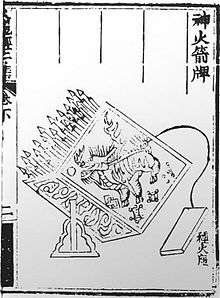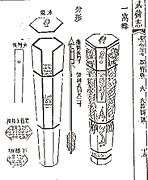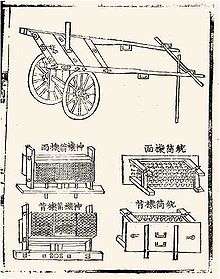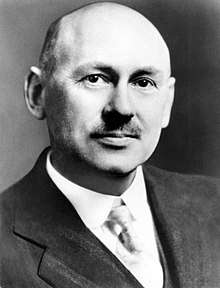History of rockets
The first rockets were used as propulsion systems for arrows, and may have appeared as early as the 10th century in Song dynasty China. However more solid documentary evidence does not appear until the 13th century. The technology probably spread across Eurasia in the wake of the Mongol invasions of the mid-13th century. Usage of rockets as weapons before modern rocketry is attested in China, Korea, the India, and Europe. One of the first recorded rocket launchers is the "wasp nest" fire arrow launcher produced by the Ming dynasty in 1380. In Europe rockets were also used in the same year at the Battle of Chioggia. The Joseon kingdom of Korea used a type of mobile multiple rocket launcher known as the "Munjong Hwacha" by 1451.
The use of rockets in war became outdated by 15th century. The use of rockets in wars was revived with the creation of iron-cased rockets, known as Mysorean rockets, which was developed in Indian Kingdom of Mysore during the mid 18th century,[1][2] and were later copied by the British. The later models and improvements were known as the Congreve rocket and used in the Napoleonic Wars.
China
The dating of the invention of the first rocket, otherwise known as the gunpowder propelled fire arrow, is disputed. The History of Song attributes the invention to two different people at different times, Feng Zhisheng in 969 and Tang Fu in 1000. However Joseph Needham argues that rockets could not have existed before the 12th century, since the gunpowder formulas listed in the Wujing Zongyao are not suitable as rocket propellant.[3]
Rockets may have been used as early as 1232, when reports appeared describing fire arrows and 'iron pots' that could be heard for 5 leagues (25 km, or 15 miles) when they exploded upon impact, causing devastation for a radius of 600 meters (2,000 feet), apparently due to shrapnel.[4] Rockets are recorded to have been used by the Song navy in a military exercise dated to 1245. Internal-combustion rocket propulsion is mentioned in a reference to 1264, recording that the 'ground-rat,' a type of firework, had frightened the Empress-Mother Gongsheng at a feast held in her honor by her son the Emperor Lizong.[5]
Subsequently, rockets are included in the military treatise Huolongjing, also known as the Fire Drake Manual, written by the Chinese artillery officer Jiao Yu in the mid-14th century. This text mentions the first known multistage rocket, the 'fire-dragon issuing from the water' (huo long chu shui), thought to have been used by the Chinese navy.[6]
Rocket launchers known as "wasp nests" were ordered by the Ming army in 1380.[7]
The American historian Frank H. Winter proposed in The Proceedings of the Twentieth and Twenty-First History Symposia of the International Academy of Astronautics that southern China and the Laotian community rocket festivals might have been key in the subsequent spread of rocketry in the Orient.[8]
Spread of rocket technology
Mongols
The Chinese fire arrow was adopted by the Mongols in northern China, who employed Chinese rocketry experts as mercenaries in the Mongol army. Rockets are thought to have spread via the Mongol invasions to other areas of Eurasia in the mid 13th century.[9]
Rocket-like weapons are reported to have been used at the Battle of Mohi in the year 1241.[10]
Middle East
Between 1270 and 1280, Hasan al-Rammah wrote his al-furusiyyah wa al-manasib al-harbiyya (The Book of Military Horsemanship and Ingenious War Devices), which included 107 gunpowder recipes, 22 of which are for rockets.[11] According to Ahmad Y Hassan, al-Rammah's recipes were more explosive than rockets used in China at the time.[12][13] The terminology used by al-Rammah indicates a Chinese origin for the gunpowder weapons he wrote about, such as rockets and fire lances.[14] Ibn al-Baitar, an Arab from Spain who had immigrated to Egypt, described saltpeter as "snow of China" (Arabic: ثلج الصين thalj al-ṣīn). Al-Baytar died in 1248.[15][16] The earlier Arab historians called saltpeter "Chinese snow" and " Chinese salt."[17][18] The Arabs used the name "Chinese arrows" to refer to rockets.[19][20][21][22][23][24][25] The Arabs called fireworks "Chinese flowers".[14] While saltpeter was called "Chinese Snow" by Arabs, it was called "Chinese salt" (Persian: نمک چینی namak-i čīnī) by the Iranians,[26][27][28][29][30] or "salt from the Chinese marshes" (namak shūra chīnī Persian: نمک شوره چيني).[31][32]
India
In 1300 Mongol mercenaries in India are recorded to have used hand held rockets.[33] By the mid-14th century Indians were also using rockets in warfare.[34]
Korea
The Korean kingdom of Joseon started producing gunpowder in 1374[35] and was producing cannons and rockets by 1377.[36][37] However the multiple rocket launching carts known as the "Munjong hwacha" did not appear until 1451.[38]
Europe
In Europe, Roger Bacon mentions gunpowder in his Opus Majus of 1267.[39]
However rockets do not feature in European warfare until the 1380 Battle of Chioggia.[40]
Konrad Kyeser described rockets in his famous military treatise Bellifortis around 1405.[41]
Jean Froissart (c. 1337 – c. 1405) had the idea of launching rockets through tubes, so that they could make more accurate flights. Froissart's idea is a forerunner of the modern bazooka.[10]
Adoption in Renaissance-era Europe
According to the 18th-century historian Ludovico Antonio Muratori, rockets were used in the war between the Republics of Genoa and Venice at Chioggia in 1380. It is uncertain whether Muratori was correct in his interpretation, as the reference might also have been to bombard, but Muratori is the source for the widespread claim that the earliest recorded European use of rocket artillery dates to 1380.[42] Konrad Kyeser described rockets in his famous military treatise Bellifortis around 1405.[41] Kyeser describes three types of rockets, swimming, free flying and captive.
Joanes de Fontana in Bellicorum instrumentorum liber (c. 1420) described flying rockets in the shape of doves, running rockets in the shape of hares, and a large car driven by three rockets, as well as a large rocket torpedo with the head of a sea monster.
In the mid-16th century, Conrad Haas wrote a book that described rocket technology that combined fireworks and weapons technologies. This manuscript was discovered in 1961, in the Sibiu public records (Sibiu public records Varia II 374). His work dealt with the theory of motion of multi-stage rockets, different fuel mixtures using liquid fuel, and introduced delta-shape fins and bell-shaped nozzles.[43]
The name Rocket comes from the Italian rocchetta, meaning "bobbin" or "little spindle",[44] given due to the similarity in shape to the bobbin or spool used to hold the thread to be fed to a spinning wheel. The Italian term was adopted into German in the mid 16th century, by Leonhard Fronsperger in a book on rocket artillery published in 1557, using the spelling rogete, and by Conrad Haas as rackette; adoption into English dates to ca. 1610.[45] Johann Schmidlap, a German fireworks maker, is believed to have experimented with staging in 1590.
Early modern history
Lagari Hasan Çelebi was a legendary Ottoman aviator who, according to an account written by Evliya Çelebi, made a successful manned rocket flight. Evliya Çelebi purported that in 1633 Lagari Hasan Çelebi launched in a 7-winged rocket using 50 okka (63.5 kg, or 140 lbs) of gunpowder from Sarayburnu, the point below Topkapı Palace in Istanbul.
Siemienowicz
"Artis Magnae Artilleriae pars prima" ("Great Art of Artillery, the First Part", also known as "The Complete Art of Artillery"), first printed in Amsterdam in 1650, was translated to French in 1651, German in 1676, English and Dutch in 1729 and Polish in 1963. For over two centuries, this work of Polish-Lithuanian Commonwealth nobleman Kazimierz Siemienowicz[46] was used in Europe as a basic artillery manual. The book provided the standard designs for creating rockets, fireballs, and other pyrotechnic devices. It contained a large chapter on caliber, construction, production and properties of rockets (for both military and civil purposes), including multi-stage rockets, batteries of rockets, and rockets with delta wing stabilizers (instead of the common guiding rods).
Indian Mysorean rockets

 A Mysorean soldier from India, using his Mysorean rocket as a flagstaff (Robert Home, 1793/4).
A Mysorean soldier from India, using his Mysorean rocket as a flagstaff (Robert Home, 1793/4)..jpg) Use of rockets in an assault by Mysorean troops on Travancore Line fortification (29 December 1789)
Use of rockets in an assault by Mysorean troops on Travancore Line fortification (29 December 1789)
In 1792, the first iron-cased rockets were successfully developed and used by Tipu Sultan - the ruler of the Kingdom of Mysore (in India) against the larger British East India Company forces during the Anglo-Mysore Wars. The British then took an active interest in the technology and developed it further during the 19th century. The Mysore rockets of this period were much more advanced than the British had previously seen, chiefly because of the use of iron tubes for holding the propellant; this enabled higher thrust and longer range for the missile (up to 2 km range). After Tipu's defeat in the Fourth Anglo-Mysore War and the capture of the Mysore iron rockets, they were influential in British rocket development, inspiring the Congreve rocket, which was soon put into use in the Napoleonic Wars.[48]
19th-century gunpowder-rocket artillery
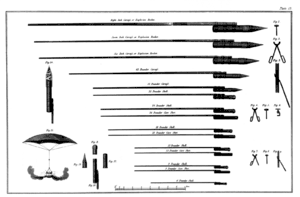
William Congreve (1772-1828), son of the Comptroller of the Royal Arsenal, Woolwich, London, became a major figure in the field. From 1801 Congreve researched the original design of Mysore rockets and started a vigorous development program at the Arsenal's laboratory.[49] Congreve prepared a new propellant mixture, and developed a rocket motor with a strong iron tube with conical nose. This early Congreve rocket weighed about 32 pounds (14.5 kilograms). The Royal Arsenal's first demonstration of solid-fuel rockets took place in 1805. The rockets were effectively used during the Napoleonic Wars and the War of 1812. Congreve published three books on rocketry.[50]
Subsequently, the use of military rockets spread throughout the western world. At the Battle of Baltimore in 1814, the rockets fired on Fort McHenry by the rocket vessel HMS Erebus were the source of the rockets' red glare described by Francis Scott Key in "The Star-Spangled Banner".[51] Rockets were also used in the Battle of Waterloo in 1815.[52]
Early rockets were very inaccurate. Without the use of spinning or any controlling feedback-loop, they had a strong tendency to veer sharply away from their intended course. The early Mysorean rockets and their successor British Congreve rockets[49] reduced veer somewhat by attaching a long stick to the end of a rocket (similar to modern bottle rockets) to make it harder for the rocket to change course. The largest of the Congreve rockets was the 32-pound (14.5 kg) Carcass, which had a 15-foot (4.6 m) stick. Originally, sticks were mounted on the side, but this was later changed to mounting them in the center of the rocket, reducing drag and enabling the rocket to be more accurately fired from a segment of pipe.
In 1815 Alexander Dmitrievich Zasyadko (1779-1837) began his work on developing military gunpowder-rockets. He constructed rocket-launching platforms (which allowed firing of rockets in salvos - 6 rockets at a time) and gun-laying devices. Zasyadko elaborated a tactic for military use of rocket weaponry. In 1820 Zasyadko was appointed head of the Petersburg Armory, Okhtensky Powder Factory, pyrotechnic laboratory and the first Highest Artillery School in Russia. He organized rocket production in a special rocket workshop and formed the first rocket sub-unit in the Imperial Russian Army.[53]
Artillery captain Józef Bem (1794-1850) of the Kingdom of Poland started experiments with what was then called in Polish raca kongrewska. These culminated in his 1819 report Notes sur les fusees incendiares (German edition: Erfahrungen über die Congrevischen Brand-Raketen bis zum Jahre 1819 in der Königlichen Polnischen Artillerie gesammelt, Weimar 1820). The research took place in the Warsaw Arsenal, where captain Józef Kosiński also developed multiple-rocket launchers adapted from horse artillery gun carriage. The 1st Rocketeer Corps formed in 1822; it first saw combat during the Polish–Russian War 1830–31.[54]
Accuracy greatly improved in 1844 when William Hale[55] modified the rocket design so that thrust was slightly vectored, causing the rocket to spin along its axis-of-travel like a bullet. The Hale rocket removed the need for a rocket stick, travelled further due to reduced air-resistance, and was far more accurate.
In 1865 the British Colonel Edward Mounier Boxer built an improved version of the Congreve rocket by placing two rockets in one tube, one behind the other.[56]
Early 20th-century rocket pioneers
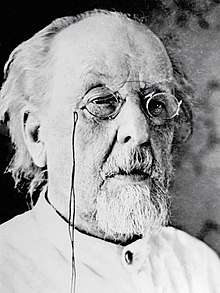
At the beginning of the 20th century, there was a burst of scientific investigation into interplanetary travel, largely driven by the inspiration of fiction by writers such as Jules Verne and H. G. Wells as well as philosophical movements like Russian cosmism.[57] Scientists seized on the rocket as a technology that was able to achieve this in real life, a possibility first recognized in 1861 by William Leitch.[58]
In 1903, high school mathematics teacher Konstantin Tsiolkovsky (1857–1935), inspired by Verne and Cosmism, published Исследование мировых пространств реактивными приборами[59] (The Exploration of Cosmic Space by Means of Reaction Devices), the first serious scientific work on space travel. The Tsiolkovsky rocket equation—the principle that governs rocket propulsion—is named in his honor (although it had been discovered previously).[60] He also advocated the use of liquid hydrogen and oxygen for propellant, calculating their maximum exhaust velocity. His work was essentially unknown outside the Soviet Union, but inside the country it inspired further research, experimentation and the formation of the Society for Studies of Interplanetary Travel in 1924.
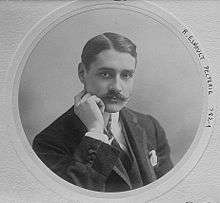
In 1912, Robert Esnault-Pelterie published a lecture[61] on rocket theory and interplanetary travel. He independently derived Tsiolkovsky's rocket equation, did basic calculations about the energy required to make round trips to the Moon and planets, and he proposed the use of atomic power (i.e. radium) to power a jet drive.
In 1912 Robert Goddard, inspired from an early age by H.G. Wells, began a serious analysis of rockets, concluding that conventional solid-fuel rockets needed to be improved in three ways. First, fuel should be burned in a small combustion chamber, instead of building the entire propellant container to withstand the high pressures. Second, rockets could be arranged in stages. Finally, the exhaust speed (and thus the efficiency) could be greatly increased to beyond the speed of sound by using a De Laval nozzle. He patented these concepts in 1914.[62] He also independently developed the mathematics of rocket flight.
During World War I Yves Le Prieur, a French naval officer and inventor, later to create a pioneering scuba diving apparatus, developed air-to-air solid-fuel rockets. The aim was to destroy observation captive balloons (called saucisses or Drachens) used by German artillery. These rather crude black powder, steel-tipped incendiary rockets (made by Ruggieri) were first tested from a Voisin aircraft, wing-bolted on a fast Picard Pictet sports car and then used in battle on real aircraft. A typical layout was eight electrically fired Le Prieur rockets fitted on the interpane struts of a Nieuport aircraft. If fired at sufficiently short distance, a spread of Le Prieur rockets proved to be quite deadly. Belgian ace Willy Coppens claimed dozens of Drachen kills during World War I.
In 1920, Goddard published his ideas and experimental results in A Method of Reaching Extreme Altitudes.[63] The work included remarks about sending a solid-fuel rocket to the Moon, which attracted worldwide attention and was both praised and ridiculed. A New York Times editorial suggested:
- "That Professor Goddard, with his 'chair' in Clark College and the countenancing of the Smithsonian Institution, does not know the relation of action to reaction, and of the need to have something better than a vacuum against which to react -- to say that would be absurd. Of course he only seems to lack the knowledge ladled out daily in high schools." —New York Times, 13 January 1920[64]
In 1923, Hermann Oberth (1894–1989) published Die Rakete zu den Planetenräumen ("The Rocket into Planetary Space"), a version of his doctoral thesis, after the University of Munich had rejected it.[65]
In 1924, Tsiolkovsky also wrote about multi-stage rockets, in 'Cosmic Rocket Trains'.[66]
Modern rocketry
Pre-World War II

Modern rockets originated when Goddard attached a supersonic (de Laval) nozzle to the combustion chamber of a liquid-fueled rocket engine. These nozzles turn the hot gas from the combustion chamber into a cooler, hypersonic, highly directed jet of gas, more than doubling the thrust and raising the engine efficiency from 2% to 64%.[67][68] On 16 March 1926 Robert Goddard launched the world's first liquid-fueled rocket in Auburn, Massachusetts.
During the 1920s, a number of rocket research organizations appeared worldwide. In 1927 the German car manufacturer Opel began to research rocket vehicles together with Mark Valier and the solid-fuel rocket builder Friedrich Wilhelm Sander.[69] In 1928, Fritz von Opel drove a rocket car, the Opel-RAK.1 on the Opel raceway in Rüsselsheim, Germany. In 1928 the Lippisch Ente flew: rocket power launched the manned glider, although it was destroyed on its second flight. In 1929 von Opel started at the Frankfurt-Rebstock airport with the Opel-Sander RAK 1-airplane, which was damaged beyond repair during a hard landing after its first flight.
In the mid-1920s, German scientists had begun experimenting with rockets that used liquid propellants capable of reaching relatively high altitudes and distances. In 1927 and also in Germany, a team of amateur rocket engineers had formed the Verein für Raumschiffahrt (Society for Space Travel, or VfR), and in 1931 launched a liquid propellant rocket (using oxygen and gasoline).[70]
Rocketry in the Soviet Union also began with amateur societies; foremost was the Group for the Study of Reactive Propulsion (GIRD) headed by Friedrich Zander and Sergei Korolev. From 1931 to 1937 in the Soviet Union, extensive scientific work on rocket engine design occurred at the Gas Dynamics Laboratory (GDL) in Leningrad, which was merged with GIRD in 1933 bringing rocketry fully under government control.[71] The well-funded and -staffed laboratory built over 100 experimental engines under the direction of Valentin Glushko. The work included regenerative cooling, hypergolic propellant ignition, and fuel injector designs that included swirling and bi-propellant mixing injectors. However, Glushko's arrest during Stalinist purges in 1938 curtailed the development.
Similar work was also done from 1932 onwards by the Austrian professor Eugen Sänger, who migrated from Austria to Germany in 1936. He worked there on rocket-powered spaceplanes such as Silbervogel (sometimes called the "antipodal" bomber).[72]
On November 12, 1932 at a farm in Stockton NJ, the American Interplanetary Society's attempt to static-fire their first rocket (based on German Rocket Society designs) failed in a fire.[73]
In 1936, a British research programme based at Fort Halstead in Kent under the direction of Dr. Alwyn Crow started work on a series of unguided solid-fuel rockets that could be used as anti-aircraft weapons. In 1939, a number of test firings were carried out in the British colony of Jamaica, on a purpose-built range.[74]
In the 1930s, the German Reichswehr (which in 1935 became the Wehrmacht) began to take an interest in rocketry.[75] Artillery restrictions imposed by the 1919 Treaty of Versailles limited Germany's access to long-distance weaponry. Seeing the possibility of using rockets as long-range artillery fire, the Wehrmacht initially funded the VfR team, but because their focus was strictly scientific, created its own research team. At the behest of military leaders, Wernher von Braun, at the time a young aspiring rocket scientist, joined the military (followed by two former VfR members) and developed long-range weapons for use in World War II by Nazi Germany.[76]
World War II

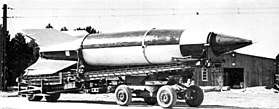
.svg.png)
At the start of the war, the British had equipped their warships with unrotated projectile unguided anti-aircraft rockets, and by 1940, the Germans had developed a surface-to-surface multiple rocket launcher, the Nebelwerfer, and the Soviets already had introduced the RS-132 air-to-ground rocket. All of these rockets were developed for a variety of roles, notably the Katyusha rocket.
In 1943, production of the V-2 rocket began in Germany. It had an operational range of 300 km (190 mi) and carried a 1,000 kg (2,200 lb) warhead, with an amatol explosive charge. It normally achieved an operational maximum altitude of around 90 km (56 mi), but could achieve 206 km (128 mi) if launched vertically. The vehicle was similar to most modern rockets, with turbopumps, inertial guidance and many other features. Thousands were fired at various Allied nations, mainly Belgium, as well as England and France. While they could not be intercepted, their guidance system design and single conventional warhead meant that they were insufficiently accurate against military targets. A total of 2,754 people in England were killed, and 6,523 were wounded before the launch campaign was ended. There were also 20,000 deaths of slave labour during the construction of V-2s. While it did not significantly affect the course of the war, the V-2 provided a lethal demonstration of the potential for guided rockets as weapons.[77][78]
In parallel with the guided missile programme in Nazi Germany, rockets were also used on aircraft, either for assisting horizontal take-off (RATO), vertical take-off (Bachem Ba 349 "Natter") or for powering them (Me 163,[79] etc.). During the war Germany also developed several guided and unguided air-to-air, ground-to-air and ground-to-ground missiles (see list of World War II guided missiles of Germany).
Post World War II
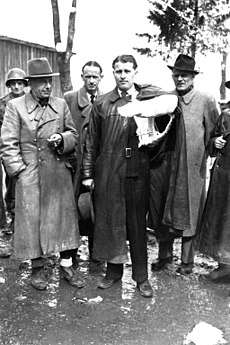 Dornberger and Von Braun after being captured by the Allies.
Dornberger and Von Braun after being captured by the Allies. R-7 8K72 "Vostok" permanently displayed at the Moscow Trade Fair at Ostankino; the rocket is held in place by its railway carrier, which is mounted on four diagonal beams that constitute the display pedestal. Here the railway carrier has tilted the rocket upright as it would do so into its launch pad structure—which is missing for this display.
R-7 8K72 "Vostok" permanently displayed at the Moscow Trade Fair at Ostankino; the rocket is held in place by its railway carrier, which is mounted on four diagonal beams that constitute the display pedestal. Here the railway carrier has tilted the rocket upright as it would do so into its launch pad structure—which is missing for this display.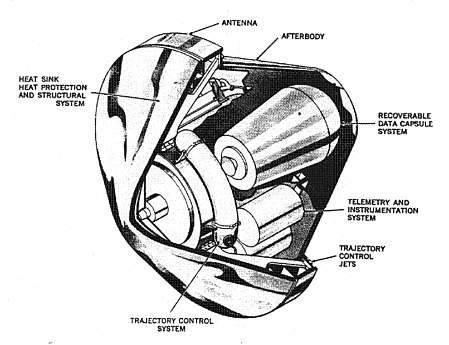 Prototype of the General Electric (USA) Mk-2 Reentry Vehicle (RV), based on blunt body theory.
Prototype of the General Electric (USA) Mk-2 Reentry Vehicle (RV), based on blunt body theory.
At the end of World War II, competing Russian, British, and US military and scientific crews raced to capture technology and trained personnel from the German rocket program at Peenemünde. Russia and Britain had some success, but the United States benefited the most. The US captured a large number of German rocket scientists, including von Braun, and brought them to the United States as part of Operation Paperclip.[57][80] In America, the same rockets that were designed to rain down on Britain were used instead by scientists as research vehicles for developing the new technology further. The V-2 evolved into the American Redstone rocket, used in the early space program.[81]
After the war, rockets were used to study high-altitude conditions, by radio telemetry of temperature and pressure of the atmosphere, detection of cosmic rays, and further research; notably the Bell X-1, the first manned vehicle to break the sound barrier. This continued in the US under von Braun and the others, who were destined to become part of the US scientific community.
Independently, in the Soviet Union's space program research continued under the leadership of the chief designer Sergei Korolev.[82] With the help of German technicians, the V-2 was duplicated and improved as the R-1, R-2, and R-5 missiles. German designs were abandoned in the late 1940s, and the foreign workers were sent home. A new series of engines built by Glushko and based on inventions of Aleksei Mihailovich Isaev formed the basis of the first ICBM, the R-7.[83] The R-7 launched the first satellite, Sputnik 1, and later Yuri Gagarin, the first man into space, and the first lunar and planetary probes. This rocket is still in use today. These prestigious events attracted the attention of top politicians, along with additional funds for further research.
One problem that had not been solved was atmospheric reentry. It had been shown that an orbital vehicle easily had enough kinetic energy to vaporize itself, and yet it was known that meteorites can make it down to the ground. The mystery was solved in the US in 1951 when H. Julian Allen and A. J. Eggers, Jr. of the National Advisory Committee for Aeronautics (NACA) made the counterintuitive discovery that a blunt shape (high drag) permitted the most effective heat shield. With this type of shape, around 99% of the energy goes into the air rather than the vehicle, and this permitted safe recovery of orbital vehicles.[84]
The Allen and Eggers discovery, initially treated as a military secret, was eventually published in 1958.[85] Blunt body theory made possible the heat shield designs that were embodied in the Mercury, Gemini, Apollo, and Soyuz space capsules, enabling astronauts and cosmonauts to survive the fiery re-entry into Earth's atmosphere. Some spaceplanes such as the Space Shuttle made use of the same theory. At the time the STS was being conceived, Maxime Faget, the Director of Engineering and Development at the Manned Spacecraft Center, was not satisfied with the purely lifting re-entry method (as proposed for the cancelled X-20 "Dyna-Soar").[86] He designed a space shuttle which operated as a blunt body by entering the atmosphere at an extremely high angle of attack of 40°[87] with the underside facing the direction of flight, creating a large shock wave that would deflect most of the heat around the vehicle instead of into it.[88] The Space Shuttle uses a combination of a ballistic entry (blunt body theory); and then at an altitude of about 122,000 m (400,000 ft), the atmosphere becomes dense enough for the aerodynamic re-entry phase to begin. Throughout re-entry, the Shuttle rolls to change lift direction in a prescribed way, keeping maximum deceleration well below 2 gs. These roll maneuvers allow the Shuttle to use its lift to steer toward the runway.[89]
Cold War
Rockets became extremely important militarily as modern intercontinental ballistic missiles (ICBMs) when it was realized that nuclear weapons carried on a rocket vehicle were essentially impossible for existing defense systems to stop once launched, and launch vehicles such as the R-7, Atlas, and Titan became delivery platforms for these weapons.
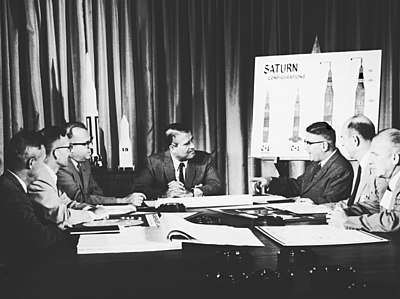
Fueled partly by the Cold War, the 1960s became the decade of rapid development of rocket technology particularly in the Soviet Union (Vostok, Soyuz, Proton) and in the United States (e.g. the X-15[91] and X-20 Dyna-Soar[92] aircraft). There was also significant research in other countries, such as France, Britain, Japan, Australia, etc., and a growing use of rockets for Space exploration, with pictures returned from the far side of the Moon and unmanned flights for Mars exploration.
In America, the manned spaceflight programs, Project Mercury, Project Gemini, and later the Apollo program, culminated in 1969 with the first manned landing on the Moon using the Saturn V, causing the New York Times to retract its earlier 1920 editorial implying that spaceflight couldn't work:
Further investigation and experimentation have confirmed the findings of Isaac Newton in the 17th century and it is now definitely established that a rocket can function in a vacuum as well as in an atmosphere. The Times regrets the error.
— New York Times, 17 June 1969 - A Correction[93]
In the 1970s, the United States made five more lunar landings before cancelling the Apollo program in 1975. The replacement vehicle, the partially reusable Space Shuttle, was intended to be cheaper,[94] but no large reduction in costs was achieved. Meanwhile, in 1973, the expendable Ariane programme was begun, a launcher that by the year 2000 would capture much of the geosat market.
Market competition
Since the early 2010s, new private options for obtaining spaceflight services emerged, bringing substantial market competition into the existing launch service provider business. Initially, these market forces have manifest through competitive dynamics among payload transport capabilities at diverse prices having a greater influence on rocket launch purchasing than the traditional political considerations of country of manufacture or the particular national entity using, regulating or licensing the launch service.[95][96][97][98]
Following the advent of spaceflight technology in the late 1950s, space launch services came into being, exclusively by national programs. Later in the 20th century commercial operators became significant customers of launch providers. International competition for the communications satellite payload subset of the launch market was increasingly influenced by commercial considerations. However, even during this period, for both commercial- and government-entity-launched commsats, the launch service providers for these payloads used launch vehicles built to government specifications, and with state-provided development funding exclusively.
In the early 2010s, privately developed launch vehicle systems and space launch service offerings emerged. Companies now faced economic incentives rather than the principally political incentives of the earlier decades. The space launch business experienced a dramatic lowering of per-unit prices along with the addition of entirely new capabilities, bringing about a new phase of competition in the space launch market.[98][95][97]
See also
References
- https://www.grc.nasa.gov/WWW/K-12/TRC/Rockets/history_of_rockets.html
- A. Bowdoin Van Riper (29 October 2007). Rockets and Missiles: The Life Story of a Technology. JHU Press. pp. 14–. ISBN 978-0-8018-8792-5.
- Lorge 2005.
- "A Brief History of Rocketry". Solarviews.com. Retrieved 2012-06-14.
- Crosby, Alfred W. (2002). Throwing Fire: Projectile Technology Through History. Cambridge: Cambridge University Press. pp. 100–103. ISBN 0-521-79158-8.
- Needham, Volume 5, Part 7, 510.
- Needham 1986, p. 514.
- Frank H. Winter, "The `Boun Bang Fai' Rockets of Thailand and Laos:", in Lloyd H. Cornett, Jr., ed., History of Rocketry and Astronautics - Proceedings of the Twentieth and Twenty-First History Symposia of the International Academy of Astronautics, AAS History Series, Vol. 15 (Univelt Inc.: San Diego, 1993), pp. 3-24.
- "Rockets appear in Arab literature in 1258 A.D., describing Mongol invaders' use of them on February 15 to capture the city of Baghdad." "A brief history of rocketry". NASA Spacelink. Retrieved 2006-08-19.
- "A brief history of rocketry". NASA Spacelink. Retrieved 2006-08-19.
- Hassan & a
- Hassan & b
- Mansour, Professor Dr. Mohamed (22 March 2002). "Muslim Rocket Technology". muslimheritage.com. Muslim Heritage Awareness Group. Retrieved 3 July 2014.
- Jack Kelly (2005). Gunpowder: Alchemy, Bombards, and Pyrotechnics: The History of the Explosive that Changed the World (illustrated ed.). Basic Books. p. 22. ISBN 0-465-03722-4.
Around 1240 the Arabs acquired knowledge of saltpeter (“Chinese snow”) from the East, perhaps through India. They knew of gunpowder soon afterward. They also learned about fireworks (“Chinese flowers”) and rockets (“Chinese arrows”). Arab warriors had acquired fire lances by 1280. Around that same year, a Syrian named Hasan al-Rammah wrote a book that, as he put it, "treat of machines of fire to be used for amusement of for useful purposes." He talked of rockets, fireworks, fire lances, and other incendiaries, using terms that suggested he derived his knowledge from Chinese sources. He gave instructions for the purification of saltpeter and the recipes for making different types of gunpowder.
- James Riddick Partington (1960). A history of Greek fire and gunpowder (reprint, illustrated ed.). JHU Press. p. 22. ISBN 0-8018-5954-9.
The first definite mention of saltpetre in an Arabic work is that in al-Baytar (d. 1248), written towards the end of his life, where it is called "snow of China." Al-Baytar was a Spanish Arab, although he travelled a good deal and lived for a time in Egypt.
- Arnold Pacey (1991). Technology in world civilization: a thousand-year history (reprint, illustrated ed.). MIT Press. p. 45. ISBN 0-262-66072-5.
Europeans were prompted by all this to take a closer interest in happenings far to the east. Four years after the invasion of 1241, the pope sent an ambassador to the Great Khan's capital in Mongolia. Other travellers followed later, of whom the most interesting was William of Rubruck (or Ruysbroek). He returned in 1257, and in the following year there are reports of experiments with gunpowder and rockets at Cologne. Then a friend of William of Rubruck, Roger Bacon, gave the first account of gunpowder and its use in fireworks to be written in Europe. A form of gunpowder had been known in China since before AD 900, and as mentioned earlier...Much of this knowledge had reached the Islamic countries by then, and the saltpetre used in making gunpowder there was sometimes referred to, significantly, as 'Chinese snow'.
- Original from the University of MichiganThe people's cyclopedia of universal knowledge with numerous appendixes invaluable for reference in all departments of industrial life... Volume 2 of The People's Cyclopedia of Universal Knowledge with Numerous Appendixes Invaluable for Reference in All Departments of Industrial Life. New York: Eaton & Mains. 1897. p. 1033.
Fire-arms may be defined as vessels—of whatever form— used in the propulsion of shot, shell, or bullets, to a greater or less distance, by the action of gunpowder exploded within them. The prevalent notion that gunpowder was the invention of Friar Bacon, and that cannon were first used by Edward III. of England, must be at once discarded. It is certain that gunpowder differed in no conspicuous degree from the Chreekfire of the Byzantine emperors, nor from the terrestrial thunder of China and India, where it had been known for many centuries before the chivalry of Europe began to fall beneath its leveling power. Niter is the natural and daily product of China and India; and there, accordingly, the knowledge of gunpowder seems to be coeval with that of the most distant historic events. The earlier Arab historians call saltpeter "Chinese snow" and " Chinese salt;" and the most ancient records of China itself show that fireworks were well known several hundred yrs. before the Christian era. From these and other circumstances it is indubitable that gunpowder was used by the Chinese as an explosive compound in prehistoric times; when they first discovered or applied its power as a propellant is less easily determined. Stone mortars, throwing missiles of 12 lbs. to a distance of 800 paces, are mentioned as having been employed in 767 A.D. by Thang's army; and in 1282 A.D. it is incontestable that the Chinese besieged in Cai'fong-fou used cannon against their Mongol enemies. Thus the Chinese must be allowed to have established their claim to an early practical knowledge of gunpowder and its effects.
- Original from Harvard University John Clark Ridpath, ed. (1897). The standard American encyclopedia of arts, sciences, history, biography, geography, statistics, and general knowledge, Volume 3. 156 Fifth Avenue, New York: Encyclopedia publishing co. p. 1033.
Fire-arms may be defined as vessels—of whatever form— used in the propulsion of shot, shell, or bullets, to a greater or less distance, by the action of gunpowder exploded within them. The prevalent notion that gunpowder was the invention of Friar Bacon, and that cannon were first used by Edward III. of England, must be at once discarded. It is certain that gunpowder differed in no conspicuous degree from the Greek fire of the Byzantine emperors, nor from the terrestrial thwuler of the Asian Countries, where it had been known for many centuries before the chivalry of Europe began to fall beneath its leveling power. Niter is the natural and daily product of China and India; and there, accordingly, the knowledge of gunpowder seems to be coeval with that of the most distant historic events. The earlier Arab historians call saltpeter "Chinese snow" and " Chinese salt j" and the most ancient records of China itself show that fireworks were well known several hundred yrs. before the Christian era. From these and other circumstances it is indubitable that gunpowder was used by the Chinese as an explosive compound in prehistoric times; when they first discovered or applied its power as a propellant is less easily determined. Stone mortars, throning missiles of 12 lbs. to a distance of 300 paces, are mentioned as having been employed in 757 A.D. by Thaug's army; and in 1232 A.D. it is incontestable that the Chinese besieged in Cai'fong-fou used cannon against their Mongol enemies. Thus the Chinese must be allowed to have established their claim to an early practical knowledge of gunpowder and its effects.
CS1 maint: location (link) - Original from the University of MichiganLillian Craig Harris (1993). China considers the Middle East (illustrated ed.). Tauris. p. 25. ISBN 1-85043-598-7.
now known precisely but, as with many other commodities, the Mongol campaigns served as one conduit. The Arabs learned of saltpetre around the end of the thirteenth century when they were introduced to it as 'Chinese snow' and began to use rockets they called 'Chinese arrows'.
- Original from the University of Michigan Thomas Francis Carter (1955). The invention of printing in China and its spread westward. Ronald Press Co. p. 126.
the Khitan, and again in the wars against the invading Jurchen in 1125-27 and 1161-62. Following the Mongol conquest of much of Asia the Arabs became acquainted with saltpeter sometime before the end of the thirteenth century. They called it Chinese snow, as they called the rocket the Chinese arrow. Roger Bacon (ca. 1214 to ca. 1294) is the first European writer to mention gunpowder, though whether he learned of it through his study of
- Original from the University of Michigan Frank Hamilton Hankins, American Sociological Association, American Sociological Society, JSTOR (Organization) (1963). American sociological review, Volume 10. American Sociological Association. p. 598.
Gunpowder appeared in Europe in the thirteenth century. The Arabs learned of gunpowder during this century and they called saltpeter "Chinese snow" and the rocket "Chinese arrow." Roger Bacon was the first European to mention gunpowder and he may have learend it from the Arabs or from his fellow Franciscan, Friar William of Rubruck. Friar William was in Mongolia in
CS1 maint: multiple names: authors list (link) - Hugh Laurence Ross, ed. (1963). Perspectives on the social order: readings in sociology. McGraw-Hill. p. 129.
Gunpowder appeared in Europe in the thirteenth century. The Arabs learned of gunpowder during this century and they called saltpeter "Chinese snow" and the rocket "Chinese arrow." Roger Bacon was the first European to mention gunpowder and he may have learend it from the Arabs or from his fellow Franciscan, Friar William of Rubruck. Friar William was in Mongolia in 1254 and Roger Bacon was personally acquainted with him after his return
- Original from the University of California Thomas Francis Carter (1925). The Invention of Printing in China and Its Spread Westward. Columbia University Press. p. 92.
When the use of these grenades first began is still obscure. They were apparently used in the battles of 1161 and 1162, and again by the northern Chinese against the Mongols in 1232. The Arabs became acquainted with saltpeter some time before the end of the thirteenth century and calledin Chinese snow, as the called the rocket the Chinese arrow. Roger Bacon (c. 1214 to c. 1294) is the first European writer to mention gunpowder, though whether he learned of it.
- Original from the University of Michigan Michael Edwardes (1971). East-West Passage: The Travel of Ideas, Arts, and Inventions Between Asia and the Western World (illustrated ed.). Taplinger Publishing Company. p. 82. ISBN 978-0-8008-2355-9.
However, the first Arab mention of saltpetre occurs towards the end of the thirteenth century, when it is called 'Chinese snow'. In any case, gunpowder became known in Europe a short time after it was used in warfare in China
- Original from the University of California Thomas Francis Carter (1955). The invention of printing in China and its spread westward (2 ed.). Ronald Press Co. p. 126. Retrieved 2011-11-28.
Following the Mongol conquest of much of Asia the Arabs became acquainted with saltpeter sometime before the end of the thirteenth century. They called it Chinese snow, as they called the rocket the Chinese arrow.
- Peter Watson (2006). Ideas: A History of Thought and Invention, from Fire to Freud (illustrated, annotated ed.). HarperCollins. p. 304. ISBN 0-06-093564-2.
The first use of a metal tube in this context was made around 1280 in the wars between the Song and the Mongols, where a new term, chong, was invented to describe the new horror...Like paper, it reached the West via the Muslims, in this case the writings of the Andalusian botanist Ibn al-Baytar, who died in Damascus in 1248. The Arabic term for saltpetre is 'Chinese snow' while the Persian usage is 'Chinese salt'.28
- Cathal J. Nolan (2006). The age of wars of religion, 1000-1650: an encyclopedia of global warfare and civilization. Volume 1 of Greenwood encyclopedias of modern world wars (illustrated ed.). Greenwood Publishing Group. p. 365. ISBN 0-313-33733-0.
In either case, there is linguistic evidence of Chinese origins of the technology: in Damascus, Arabs called the saltpeter used in making gunpowder " Chinese snow," while in Iran it was called "Chinese salt." Whatever the migratory route
- Original from the University of Michigan Oliver Frederick Gillilan Hogg (1970). Artillery: its origin, heyday, and decline (illustrated ed.). Archon Books. p. 123.
The Chinese were certainly acquainted with saltpetre, the essential ingredient of gunpowder. They called it Chinese Snow and employed it early in the Christian era in the manufacture of fireworks and rockets.
- Original from the University of Michigan Oliver Frederick Gillilan Hogg (1963). English artillery, 1326-1716: being the history of artillery in this country prior to the formation of the Royal Regiment of Artillery. Royal Artillery Institution. p. 42.
The Chinese were certainly acquainted with saltpetre, the essential ingredient of gunpowder. They called it Chinese Snow and employed it early in the Christian era in the manufacture of fireworks and rockets.
- Oliver Frederick Gillilan Hogg (1993). Clubs to cannon: warfare and weapons before the introduction of gunpowder (reprint ed.). Barnes & Noble Books. p. 216. ISBN 1-56619-364-8.
The Chinese were certainly acquainted with saltpetre, the essential ingredient of gunpowder. They called it Chinese snow and used it early in the Christian era in the manufacture of fireworks and rockets.
- Partington, J. R. (1960). A History of Greek Fire and Gunpowder (illustrated, reprint ed.). JHU Press. p. 335. ISBN 0801859549.
- Needham, Joseph; Yu, Ping-Yu (1980). Needham, Joseph (ed.). Science and Civilisation in China: Volume 5, Chemistry and Chemical Technology, Part 4, Spagyrical Discovery and Invention: Apparatus, Theories and Gifts. Volume 5. Contributors Joseph Needham, Lu Gwei-Djen, Nathan Sivin (illustrated, reprint ed.). Cambridge University Press. p. 194. ISBN 052108573X.
- Roy 2015, p. 115.
- Khan 2008, p. 63.
- Seoul National University-College of Humanities-Department of History (2005-04-30). "History of Science in Korea". Vestige of Scientific work in Korea. Seoul National University. Retrieved 2006-07-27.
- Korean Broadcasting System-News department (2005-04-30). "Science in Korea". Countdown Begins for Launch of South Korea’s Space Rocket. Korean Broadcasting System. Retrieved 2006-07-27.
- Chase 2003, p. 173.
- edited; Project, published by Korean Spirit & Culture Promotion (2007). Fifty wonders of Korea Volume 2. Science and Technology (PDF). Seoul: Korean Spirit & Culture Promotion Project. p. 62. ISBN 978-0-9797263-4-7. Archived from the original (PDF) on 2012-09-04. Retrieved 3 July 2014.
- Kelly 2004, p. 25.
- Needham 1986, p. 516.
- "Rockets and Missiles: The Life Story of a Technology", A. Bowdoin Van Riper, p.10
- Ley, Geschichte der Rakete, 1932.
- "CONRAD HAAS Raketenpionier in Siebenbürgen (german)". Sibiweb.de. Retrieved 2012-12-10.
- a diminutive of rocca "distaff", itself from a Germanic source.
- English rocket from c. 1610, adopted from the Italian term. Jim Bernhard, Porcupine, Picayune, & Post: How Newspapers Get Their Names (2007), p. 126.
- Tadeusz Nowak "Kazimierz Siemienowicz, ca.1600-ca.1651", MON Press, Warsaw 1969, p.182
- "Missiles mainstay of Pak's N-arsenal". The Times of India. 21 April 2008. Retrieved 2011-08-30.
- Roddam Narasimha (1985). Rockets in Mysore and Britain, 1750-1850 A.D. Archived 2012-03-03 at the Wayback Machine National Aeronautical Laboratory and Indian Institute of Science.
- Stephens 1887
- Van Riper 2004
- British Rockets at the US National Park Service, Fort McHenry National Monument and Historic Shrine. Retrieved February 2008.
- History of the Rocket - 1804 to 1815 by Gareth Glover
- John Pike. "Marine Corps Artillery Rockets: Back Through The Future". Globalsecurity.org. Retrieved 2012-06-14.
- Szczygielska, Małgorzata (2013). "Rakietnicy konni Królestwa Polskiego" (in Polish). Retrieved 25 March 2016.
- Space History Division 1999
- "John Dennett: Isle of Wight Rocket Man". virgin.net. Archived from the original on 23 August 2013. Retrieved 7 April 2015.
- Benson, Michael (20 July 2019). "Science Fiction Sent Man to the Moon - Neil Armstrong's first small step owed more than you'd think to the footsteps of Jules Verne, H.G. Wells and Fritz Lang". The New York Times. Retrieved 20 July 2019.
- "William Leitch Presbyterian Scientist". apogeebooks.com. Retrieved 22 November 2016.
- Tsiolkovsky's Исследование мировых пространств реактивными приборами - The Exploration of Cosmic Space by Means of Reaction Devices (Russian paper) Archived 2008-10-19 at the Wayback Machine
- Johnson 1995, pp. 499–521
- Esnault-Pelterie 1913
- "US patent 1,102,653". Patft.uspto.gov. 1914-07-07. Retrieved 2012-12-10.
- Goddard 1919
- "Topics of the Times". New York Times. January 13, 1920. Archived from the original on 2008-02-09. Retrieved 2007-06-21.
- Jürgen Heinz Ianzer, Hermann Oberth, pǎrintele zborului cosmic ("Hermann Oberth, Father of Cosmic Flight") (in Romanian), pp. 3, 11, 13, 15.
- inventors (2012-04-09). "Konstantin Tsiolkovsky - Rockets from Russia". Inventors.about.com. Retrieved 2012-12-10.
- Goddard 2002, pp. 2,15
- Clary 2003, pp. 44–45
- "The Internet Encyclopedia of Science, history of rocketry: Opel-RAK". Daviddarling.info. Retrieved 2012-12-10.
- "History of Rocketry: Verein für Raumschiffahrt (VfR)". Daviddarling.info. 2007-02-01. Retrieved 2012-12-10.
- Gray, Dale M. "Amateur Rocketry Takes Flight". Frontier Historical Consultants. Retrieved 19 October 2017.
- "A Rocket Drive For Long Range Bombers by E. Saenger and J. Bredt, August 1944" (PDF). Retrieved 2012-12-10.
- Winter, Frank H; van der Linden, Robert (November 2007), "Out of the Past", Aerospace America, p. 39
- Edgerton, David (2012), Britain's War Machine: Weapons, Resources, and Experts in the Second World War Penguin Books, ISBN 978-0141026107 (p. 42)
- Zaloga 2003, p. 3
- "The V-2 ballistic missile". Russianspaceweb.com. Retrieved 2012-12-10.
- Hunt 1991, pp. 72–74
- Béon 1997
- "Messerschmitt Me 163 Komet." World War 2 Planes. Retrieved: 22 March 2009.
- "Joint Intelligence Objectives Agency. US National Archives and Records Administration". Archives.gov. 2011-10-19. Retrieved 2012-12-10.
- von Braun 1963, pp. 452–465
- "International Space Hall of Fame: Sergei Korolev". Nmspacemuseum.org. Retrieved 2012-12-10.
- "Rocket R-7". S.P.Korolev RSC Energia.
- Hansen 1987 Chapter 12.
- Allen & Eggers 1958
- Launius, Roger D.; Jenkins, Dennis R. (2012). Coming home: reentry and recovery from space (PDF). Washington, DC: National Aeronautics and Space Administration. p. x. ISBN 978-0-16-091064-7. Retrieved 4 April 2015.
- Viviani, Antonio; Pezzella, Giuseppe (January 3, 2011). "Heat Transfer Analysis for a Winged Reentry Flight Test Bed". International Journal of Engineering (IJE). 3 (3): 341. CiteSeerX 10.1.1.301.9032.
- Launius, Roger D.; Jenkins, Dennis R. (2012). Coming home: reentry and recovery from space (PDF). Washington, DC: National Aeronautics and Space Administration. p. 187. ISBN 978-0-16-091064-7. Retrieved 3 April 2015.
- "Returning from Space: Re-entry" (PDF). Federal Aviation Administration. U.S. Department of Transportation. Washington, DC 20591. FOIA Library. pp. 4.1.7-335. Archived from the original (PDF) on 19 March 2015. Retrieved 7 April 2015.
- http://www.capcomespace.net/dossiers/espace_europeen/ariane/index.htm
- "(PDF) Hypersonics Before the Shuttle: A Concise History of the X-15 Research Airplane (NASA SP-2000-4518, 2000)" (PDF). Retrieved 2012-12-10.
- Houchin 2006
- Kuntz, Tom (2001-11-14). "New York Times 17 June 1969 - A Correction". Nytimes.com. Retrieved 16 April 2019.
- GAO 1972
- "Europe to press ahead with Ariane 6 rocket". BBC News. Retrieved 16 April 2019.
- Belfiore, Michael (2013-12-09). "The Rocketeer". Foreign Policy. Retrieved 16 April 2019.
-
Pasztor, Andy (2015-09-17). "U.S. Rocket Supplier Looks to Break 'Short Leash'". Wall Street Journal. Retrieved 16 April 2019.
" The aerospace giants [Boeing Co. and Lockheed Martin Corp.] shared almost $500 million in equity profits from the rocket-making venture last year, when it still had a monopoly on the business of blasting the Pentagon's most important satellites into orbit. But since then, 'they've had us on a very short leash,' Tory Bruno, United Launch's chief executive", said.
-
Davenport, Christian (2016-08-19). "The inside story of how billionaires are racing to take you to outer space". Washington Post. Retrieved 16 April 2019.
the government’s monopoly on space travel is over
Bibliography
- Adle, Chahryar (2003), History of Civilizations of Central Asia: Development in Contrast: from the Sixteenth to the Mid-Nineteenth Century
- Ágoston, Gábor (2008), Guns for the Sultan: Military Power and the Weapons Industry in the Ottoman Empire, Cambridge University Press, ISBN 978-0-521-60391-1
- Agrawal, Jai Prakash (2010), High Energy Materials: Propellants, Explosives and Pyrotechnics, Wiley-VCH
- Andrade, Tonio (2016), The Gunpowder Age: China, Military Innovation, and the Rise of the West in World History, Princeton University Press, ISBN 978-0-691-13597-7.
- Arnold, Thomas (2001), The Renaissance at War, Cassell & Co, ISBN 0-304-35270-5
- Benton, Captain James G. (1862). A Course of Instruction in Ordnance and Gunnery (2 ed.). West Point, New York: Thomas Publications. ISBN 1-57747-079-6.
- Brown, G. I. (1998), The Big Bang: A History of Explosives, Sutton Publishing, ISBN 0-7509-1878-0.
- Buchanan, Brenda J., ed. (2006), Gunpowder, Explosives and the State: A Technological History, Aldershot: Ashgate, ISBN 0-7546-5259-9
- Chase, Kenneth (2003), Firearms: A Global History to 1700, Cambridge University Press, ISBN 0-521-82274-2.
- Cocroft, Wayne (2000), Dangerous Energy: The archaeology of gunpowder and military explosives manufacture, Swindon: English Heritage, ISBN 1-85074-718-0
- Cowley, Robert (1993), Experience of War, Laurel.
- Cressy, David (2013), Saltpeter: The Mother of Gunpowder, Oxford University Press
- Crosby, Alfred W. (2002), Throwing Fire: Projectile Technology Through History, Cambridge University Press, ISBN 0-521-79158-8.
- Curtis, W. S. (2014), Long Range Shooting: A Historical Perspective, WeldenOwen.
- Earl, Brian (1978), Cornish Explosives, Cornwall: The Trevithick Society, ISBN 0-904040-13-5.
- Easton, S. C. (1952), Roger Bacon and His Search for a Universal Science: A Reconsideration of the Life and Work of Roger Bacon in the Light of His Own Stated Purposes, Basil Blackwell
- Ebrey, Patricia B. (1999), The Cambridge Illustrated History of China, Cambridge University Press, ISBN 0-521-43519-6
- Grant, R.G. (2011), Battle at Sea: 3,000 Years of Naval Warfare, DK Publishing.
- Hadden, R. Lee. 2005. "Confederate Boys and Peter Monkeys." Armchair General. January 2005. Adapted from a talk given to the Geological Society of America on March 25, 2004.
- Harding, Richard (1999), Seapower and Naval Warfare, 1650-1830, UCL Press Limited
- al-Hassan, Ahmad Y. (2001), "Potassium Nitrate in Arabic and Latin Sources", History of Science and Technology in Islam, retrieved 23 July 2007.
- Hobson, John M. (2004), The Eastern Origins of Western Civilisation, Cambridge University Press.
- Johnson, Norman Gardner. "explosive". Encyclopædia Britannica. Chicago: Encyclopædia Britannica Online.
- Kelly, Jack (2004), Gunpowder: Alchemy, Bombards, & Pyrotechnics: The History of the Explosive that Changed the World, Basic Books, ISBN 0-465-03718-6.
- Khan, Iqtidar Alam (1996), "Coming of Gunpowder to the Islamic World and North India: Spotlight on the Role of the Mongols", Journal of Asian History, 30: 41–5.
- Khan, Iqtidar Alam (2004), Gunpowder and Firearms: Warfare in Medieval India, Oxford University Press
- Khan, Iqtidar Alam (2008), Historical Dictionary of Medieval India, The Scarecrow Press, Inc., ISBN 978-0-8108-5503-8
- Kinard, Jeff (2007), Artillery An Illustrated History of its Impact
- Konstam, Angus (2002), Renaissance War Galley 1470-1590, Osprey Publisher Ltd..
- Liang, Jieming (2006), Chinese Siege Warfare: Mechanical Artillery & Siege Weapons of Antiquity, Singapore, Republic of Singapore: Leong Kit Meng, ISBN 981-05-5380-3
- Lidin, Olaf G. (2002), Tanegashima – The Arrival of Europe in Japan, Nordic Inst of Asian Studies, ISBN 8791114128
- Lorge, Peter (2005), Warfare in China to 1600, Routledge
- Lorge, Peter A. (2008), The Asian Military Revolution: from Gunpowder to the Bomb, Cambridge University Press, ISBN 978-0-521-60954-8
- Lu, Gwei-Djen (1988), "The Oldest Representation of a Bombard", Technology and Culture, 29 (3): 594–605, doi:10.2307/3105275, JSTOR 3105275
- McLachlan, Sean (2010), Medieval Handgonnes
- McNeill, William Hardy (1992), The Rise of the West: A History of the Human Community, University of Chicago Press.
- Morillo, Stephen (2008), War in World History: Society, Technology, and War from Ancient Times to the Present, Volume 1, To 1500, McGraw-Hill, ISBN 978-0-07-052584-9
- Needham, Joseph (1980), Science & Civilisation in China, 5 pt. 4, Cambridge University Press, ISBN 0-521-08573-X
- Needham, Joseph (1986), Science & Civilisation in China, V:7: The Gunpowder Epic, Cambridge University Press, ISBN 0-521-30358-3.
- Nicolle, David (1990), The Mongol Warlords: Ghengis Khan, Kublai Khan, Hulegu, Tamerlane
- Nolan, Cathal J. (2006), The Age of Wars of Religion, 1000–1650: an Encyclopedia of Global Warfare and Civilization, Vol 1, A-K, 1, Westport & London: Greenwood Press, ISBN 0-313-33733-0
- Norris, John (2003), Early Gunpowder Artillery: 1300–1600, Marlborough: The Crowood Press.
- Partington, J. R. (1960), A History of Greek Fire and Gunpowder, Cambridge, UK: W. Heffer & Sons.
- Partington, J. R. (1999), A History of Greek Fire and Gunpowder, Baltimore: Johns Hopkins University Press, ISBN 0-8018-5954-9
- Patrick, John Merton (1961), Artillery and warfare during the thirteenth and fourteenth centuries, Utah State University Press.
- Pauly, Roger (2004), Firearms: The Life Story of a Technology, Greenwood Publishing Group.
- Perrin, Noel (1979), Giving up the Gun, Japan's reversion to the Sword, 1543–1879, Boston: David R. Godine, ISBN 0-87923-773-2
- Petzal, David E. (2014), The Total Gun Manual (Canadian edition), WeldonOwen.
- Phillips, Henry Prataps (2016), The History and Chronology of Gunpowder and Gunpowder Weapons (c.1000 to 1850), Notion Press
- Purton, Peter (2010), A History of the Late Medieval Siege, 1200–1500, Boydell Press, ISBN 978-1-84383-449-6
- Robins, Benjamin (1742), New Principles of Gunnery
- Rose, Susan (2002), Medieval Naval Warfare 1000-1500, Routledge
- Roy, Kaushik (2015), Warfare in Pre-British India, Routledge
- Schmidtchen, Volker (1977a), "Riesengeschütze des 15. Jahrhunderts. Technische Höchstleistungen ihrer Zeit", Technikgeschichte 44 (2): 153–173 (153–157)
- Schmidtchen, Volker (1977b), "Riesengeschütze des 15. Jahrhunderts. Technische Höchstleistungen ihrer Zeit", Technikgeschichte 44 (3): 213–237 (226–228)
- Tran, Nhung Tuyet (2006), Viêt Nam Borderless Histories, University of Wisconsin Press.
- Turnbull, Stephen (2003), Fighting Ships Far East (2: Japan and Korea Ad 612-1639, Osprey Publishing, ISBN 1-84176-478-7
- Urbanski, Tadeusz (1967), Chemistry and Technology of Explosives, III, New York: Pergamon Press.
- Villalon, L. J. Andrew (2008), The Hundred Years War (part II): Different Vistas, Brill Academic Pub, ISBN 978-90-04-16821-3
- Wagner, John A. (2006), The Encyclopedia of the Hundred Years War, Westport & London: Greenwood Press, ISBN 0-313-32736-X
- Watson, Peter (2006), Ideas: A History of Thought and Invention, from Fire to Freud, Harper Perennial (2006), ISBN 0-06-093564-2
- Willbanks, James H. (2004), Machine guns: an illustrated history of their impact, ABC-CLIO, Inc.

